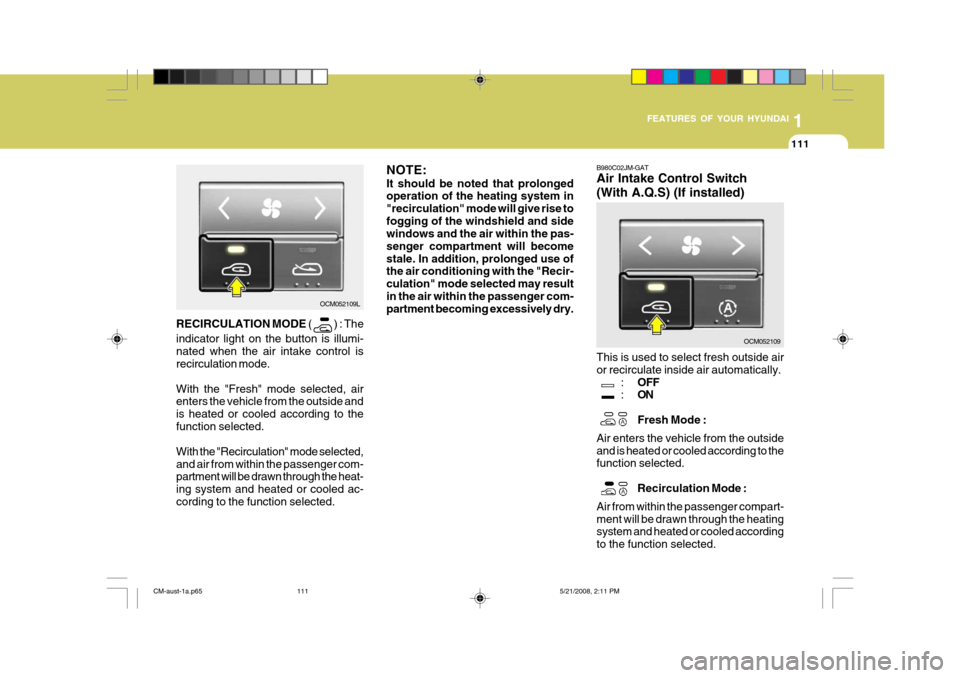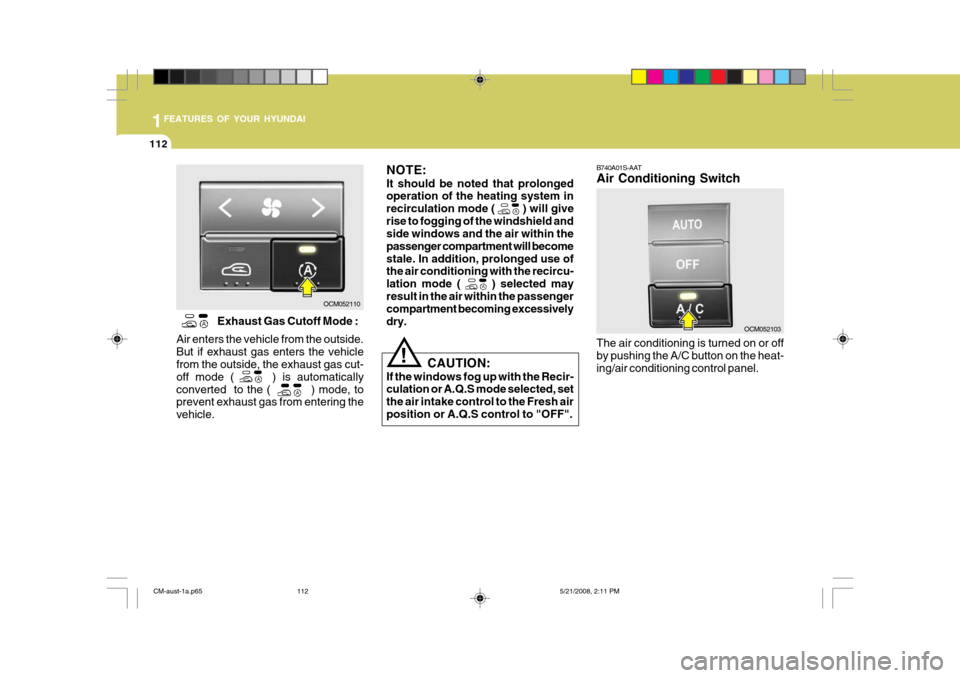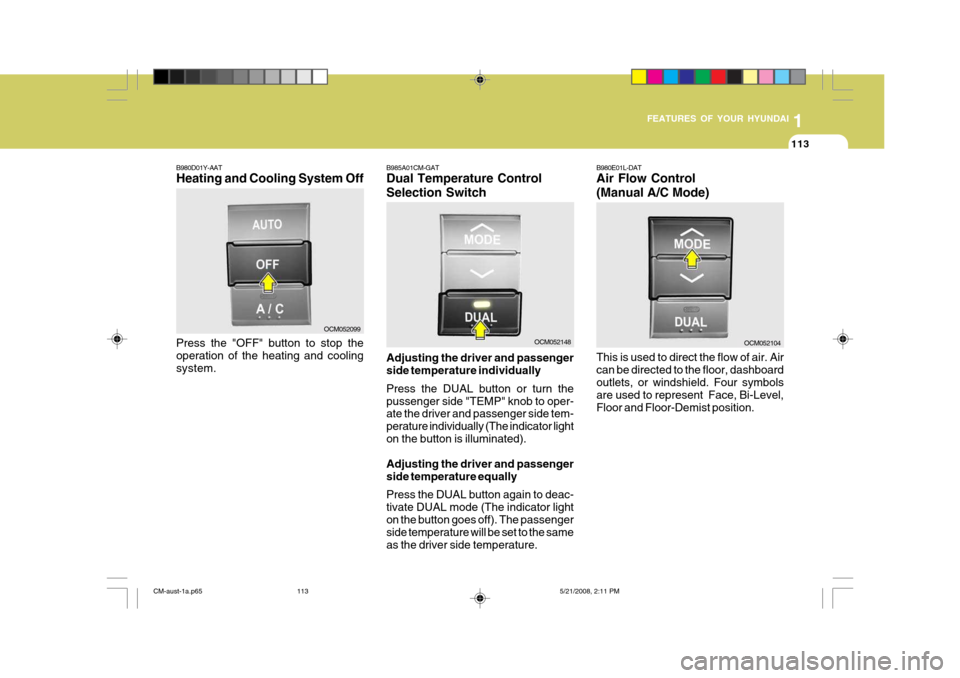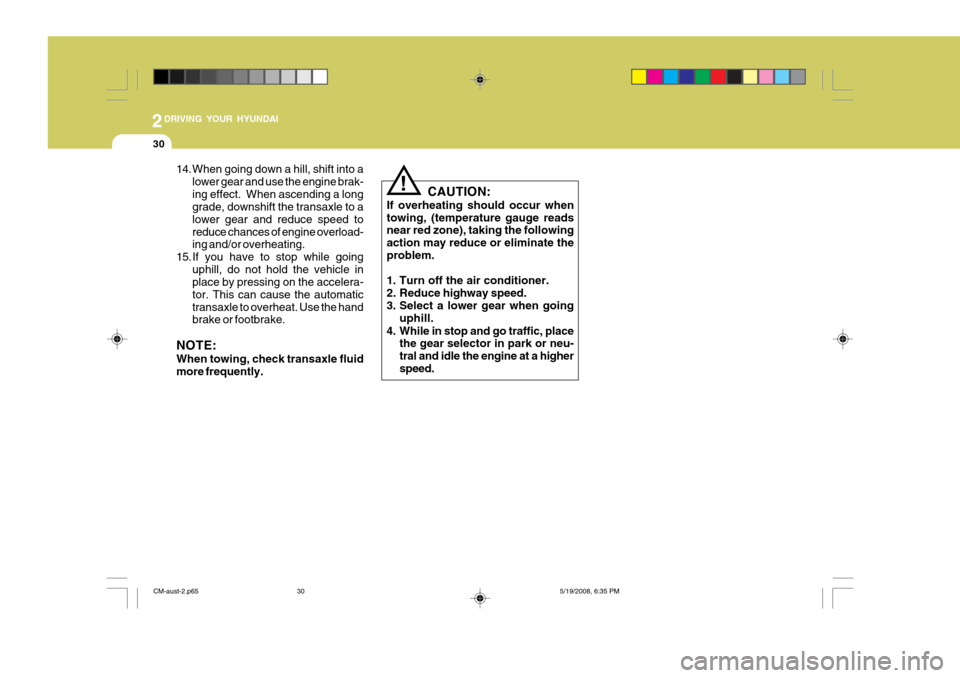2009 Hyundai Santa Fe heating
[x] Cancel search: heatingPage 122 of 269

1
FEATURES OF YOUR HYUNDAI
111
OCM052109L
RECIRCULATION MODE (
) : The
indicator light on the button is illumi- nated when the air intake control is recirculation mode. With the "Fresh" mode selected, air enters the vehicle from the outside and is heated or cooled according to thefunction selected. With the "Recirculation" mode selected, and air from within the passenger com- partment will be drawn through the heat- ing system and heated or cooled ac-cording to the function selected. NOTE: It should be noted that prolonged operation of the heating system in "recirculation" mode will give rise tofogging of the windshield and side windows and the air within the pas- senger compartment will becomestale. In addition, prolonged use of the air conditioning with the "Recir- culation" mode selected may resultin the air within the passenger com- partment becoming excessively dry.
B980C02JM-GAT Air Intake Control Switch (With A.Q.S) (If installed) This is used to select fresh outside air or recirculate inside air automatically.
:OFF
: ON Fresh Mode :
Air enters the vehicle from the outside and is heated or cooled according to the function selected.
Recirculation Mode :
Air from within the passenger compart- ment will be drawn through the heating system and heated or cooled according to the function selected.
OCM052109
CM-aust-1a.p65 5/21/2008, 2:11 PM
111
Page 123 of 269

1FEATURES OF YOUR HYUNDAI
112
B740A01S-AAT Air Conditioning Switch The air conditioning is turned on or off by pushing the A/C button on the heat-ing/air conditioning control panel.
OCM052103
!
Exhaust Gas Cutoff Mode :
Air enters the vehicle from the outside. But if exhaust gas enters the vehicle from the outside, the exhaust gas cut- off mode ( ) is automaticallyconverted to the ( ) mode, to prevent exhaust gas from entering the vehicle.CAUTION:
If the windows fog up with the Recir- culation or A.Q.S mode selected, set the air intake control to the Fresh airposition or A.Q.S control to "OFF".
OCM052110 NOTE: It should be noted that prolonged operation of the heating system in recirculation mode (
) will give
rise to fogging of the windshield and side windows and the air within the passenger compartment will becomestale. In addition, prolonged use of the air conditioning with the recircu- lation mode (
) selected may
result in the air within the passenger compartment becoming excessively dry.
CM-aust-1a.p65 5/21/2008, 2:11 PM
112
Page 124 of 269

1
FEATURES OF YOUR HYUNDAI
113
B980D01Y-AAT Heating and Cooling System Off B980E01L-DATAir Flow Control (Manual A/C Mode) This is used to direct the flow of air. Air can be directed to the floor, dashboardoutlets, or windshield. Four symbols are used to represent Face, Bi-Level, Floor and Floor-Demist position.
Press the "OFF" button to stop theoperation of the heating and coolingsystem.
OCM052099
OCM052104
B985A01CM-GAT Dual Temperature Control Selection Switch Adjusting the driver and passenger side temperature individually Press the DUAL button or turn the pussenger side "TEMP" knob to oper- ate the driver and passenger side tem- perature individually (The indicator lighton the button is illuminated). Adjusting the driver and passenger side temperature equally Press the DUAL button again to deac- tivate DUAL mode (The indicator light on the button goes off). The passenger side temperature will be set to the sameas the driver side temperature. OCM052148
CM-aust-1a.p65
5/21/2008, 2:11 PM
113
Page 126 of 269

1
FEATURES OF YOUR HYUNDAI
115
B980F01O-DAT Demist Switch When the "Demist" button is pressed, the "
" mode will be automatically
selected and the air will be discharged through the windshield demister nozzle, side demister nozzle and side ventila- tor. To assist in demisting, the air con-ditioning will operate if ambient tem- perature is higher than 3.5°C and auto- matically turns off if the ambient tem-perature drops below 3.5°C.
Floor-Demist Level
When selecting the "Floor-Demist Level" mode, the indicator light will come on and the air will be discharged throughthe windshield demister nozzle, the floor vents, side demister nozzle and side ventilator.
OCM052108R
OCM052076R B740D01Y-AAT Operation Tips
o If the interior of the car is hot when
you first get in, open the windows for a few minutes to expel the hot air.
o When you are using the air condition-
ing system, keep all windows closedto keep hot air out.
o When moving slowly, as in heavy
traffic, shift to a lower gear. Thisincreases engine speed, which in turn increases the speed of the air conditioning compressor.
o On steep grades, turn the air condi- tioning off to avoid the possibility ofthe engine overheating.
o During winter months or in periods when the air conditioning is not usedregularly, run the air conditioning onceevery month for a few minutes. This will help circulate the lubricants and keep your system in peak operatingcondition.
CM-aust-1a.p65 5/21/2008, 2:12 PM
115
Page 151 of 269

2DRIVING YOUR HYUNDAI
6
!
C050B02S-AAT Normal Conditions The Starting Procedure:
1. Insert key, and fasten the seat belt.
2. Depress the clutch pedal fully and
place the gearshift lever (manual transaxle) in neutral or the selector lever (automatic transaxle) in "P" (park) position.
3. After turning the ignition key to the "ON" position, make certain all warn-ing lights and gauges are functioningproperly before starting the engine.
4. On vehicles equipped with the diesel
preheat indication light, turn the igni-tion key to the "ON" position. The diesel-preheat indicator light will first illuminate in amber, and then after ashort time, the amber illumination will go off, indicating that preheating is completed.
STARTING
C050A01A-AAT
WARNING:
Never run the engine in a closed or poorly ventilated area any longerthan is needed to move your car in or out of the area. The carbon monox- ide gas emitted is odorless and cancause serious injury or death. C050A01E
LOCK
ON
START
C050B01HP
Amber lamp ON Amber lamp OFF
NOTE: If the engine were not started within 10 seconds after the preheating iscompleted, turn the ignition key once more to the "LOCK" position, and then to the "ON" position, in order topreheat again.
CM-aust-2.p65 5/19/2008, 6:34 PM
6
Page 165 of 269

2DRIVING YOUR HYUNDAI
20
!
GOOD BRAKING PRACTICES
C130A01A-DAT o Don't coast down hills with the car
out of gear. This is extremely haz- ardous. Keep the car in gear at all times, use the brakes to slow down,then shift to a lower gear so thatengine braking will help you maintaina safe speed.
o Don't "ride" the brake pedal. Resting
your foot on the brake pedal whiledriving can be dangerous because itcan result in the brakes overheatingand losing their effectiveness. It alsoincreases the wear of the brake com-ponents.
o If a tyre goes flat while you are driving, apply the brakes gently andkeep the car pointed straight aheadwhile you slow down. When you aremoving slowly enough for it to besafe to do so, pull off the road and stop in a safe place.
o If your car is equipped with an auto-
matic transaxle, don't let your car creep forward. To avoid creepingforward, keep your foot on the brakepedal when the car is stopped.
o Use caution when parking on a hill. Engage the parking brake and placethe gear selector lever in "P" (auto-matic transaxle) or in first or re-
verse gear (manual transaxle).
WARNING:
Nothing should be carried on top ofthe shelf panel behind the rear seat. If there were an accident or a suddenstop, such objects could move for- ward and cause damage to the ve- hicle or injure the occupants.
o After being parked, check to be sure the parking brake is not engaged and that the parking brake indicator light is out before driving away.
o Driving through water may get the brakes wet. They can also get wet when the car is washed. Wet brakescan be dangerous! Your car will not stop as quickly if the brakes are wet. Wet brakes cause the car to pull toone side. To dry the brakes, apply the brakes lightly until the braking action returns to normal, taking careto keep the car under control at all times. If the braking action does not return to normal, stop as soon as it issafe to do so and call your Hyundai dealer for assistance.
1) Pressing the 4WD lock button on
the tough terrain, the driving power is equally distributed to the front and rear. 4WD lock keeps activating when not exceeding 40 km/h.
2) Release the 4WD lock button on the normal driving conditions.
1)
2)
OCM051047L
CM-aust-2.p65 5/19/2008, 6:35 PM
20
Page 170 of 269

2
DRIVING YOUR HYUNDAI
25
C160J01A-AAT Don't Let Ice and Snow Accumu- late Underneath Under some conditions, snow and ice can build up under the fenders andinterfere with the steering. When driving in severe winter conditions where this may happen, you should periodicallycheck underneath the car to be sure the movement of the front wheels and the steering components are not obstructed. C160K01A-DAT Carry Emergency Equipment Depending on the severity of the weather where you drive your car, you should carry appropriate emergency equip-ment. Some of the items you may want to carry include tyre chains, tow straps or chains, flashlight, emergency flares,sand, a shovel, jumper cables, a win- dow scraper, gloves, ground cloth, cov- eralls, a blanket, etc.HIGHER SPEED MOTORING
C170A01A-DAT Pre-Trip Inspections
1. Tyres: Adjust the tyre inflation pressures tospecification. Low tyre inflation pres- sures will result in overheating and possible failure of the tyres. Avoid us-ing worn or damaged tyres which may result in reduced traction or tyre failure. NOTE: Never exceed the maximum tyre in- flation pressure shown on the tyres.
2. Fuel, engine coolant and engine oil: High speed travel consumes more fuel than urban motoring. Do not forget tocheck both engine coolant and engine oil.
3. Drive belt: A loose or damaged drive belt may result in overheating of the engine.
C160I01A-AAT Don't Let Your Parking Brake Freeze Under some conditions your parking brake can freeze in the engaged posi-tion. This is most likely to happen when there is an accumulation of snow or ice around or near the rear brakes or if thebrakes are wet. If there is a risk the parking brake may freeze, apply it only temporarily while you put the gearselector lever in "P" (automatic) or in first or reverse gear (manual transaxle) and block the rear wheels so the carcannot roll. Then release the parking brake.
CM-aust-2.p65
5/19/2008, 6:35 PM
25
Page 175 of 269

2DRIVING YOUR HYUNDAI
30
CAUTION:
If overheating should occur when towing, (temperature gauge reads near red zone), taking the following action may reduce or eliminate theproblem.
1. Turn off the air conditioner.
2. Reduce highway speed.
3. Select a lower gear when going uphill.
4. While in stop and go traffic, place the gear selector in park or neu-tral and idle the engine at a higher speed.
!
14. When going down a hill, shift into a
lower gear and use the engine brak- ing effect. When ascending a long grade, downshift the transaxle to a lower gear and reduce speed toreduce chances of engine overload- ing and/or overheating.
15. If you have to stop while going uphill, do not hold the vehicle inplace by pressing on the accelera- tor. This can cause the automatictransaxle to overheat. Use the hand brake or footbrake.
NOTE: When towing, check transaxle fluid more frequently.
CM-aust-2.p65 5/19/2008, 6:35 PM
30